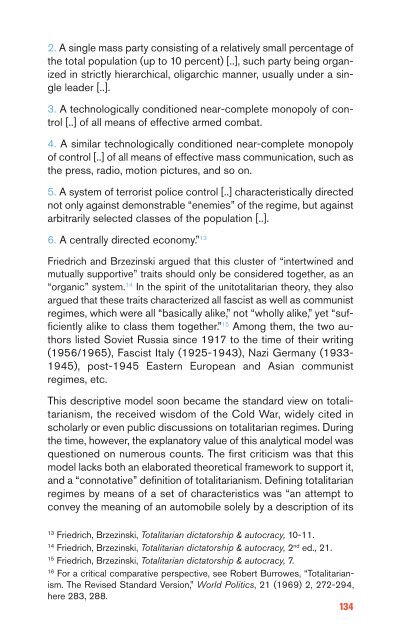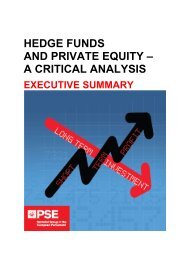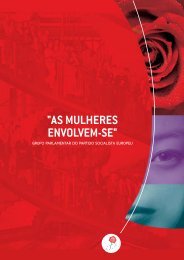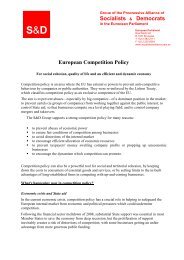Politics of the past: the use and abuse of history - Socialists ...
Politics of the past: the use and abuse of history - Socialists ...
Politics of the past: the use and abuse of history - Socialists ...
You also want an ePaper? Increase the reach of your titles
YUMPU automatically turns print PDFs into web optimized ePapers that Google loves.
2. A single mass party consisting <strong>of</strong> a relatively small percentage <strong>of</strong><br />
<strong>the</strong> total population (up to 10 percent) [..], such party being organized<br />
in strictly hierarchical, oligarchic manner, usually under a single<br />
leader [..].<br />
3. A technologically conditioned near-complete monopoly <strong>of</strong> control<br />
[..] <strong>of</strong> all means <strong>of</strong> effective armed combat.<br />
4. A similar technologically conditioned near-complete monopoly<br />
<strong>of</strong> control [..] <strong>of</strong> all means <strong>of</strong> effective mass communication, such as<br />
<strong>the</strong> press, radio, motion pictures, <strong>and</strong> so on.<br />
5. A system <strong>of</strong> terrorist police control [..] characteristically directed<br />
not only against demonstrable “enemies” <strong>of</strong> <strong>the</strong> regime, but against<br />
arbitrarily selected classes <strong>of</strong> <strong>the</strong> population [..].<br />
6. A centrally directed economy.” 13<br />
Friedrich <strong>and</strong> Brzezinski argued that this cluster <strong>of</strong> “intertwined <strong>and</strong><br />
mutually supportive” traits should only be considered toge<strong>the</strong>r, as an<br />
“organic” system. 14 In <strong>the</strong> spirit <strong>of</strong> <strong>the</strong> unitotalitarian <strong>the</strong>ory, <strong>the</strong>y also<br />
argued that <strong>the</strong>se traits characterized all fascist as well as communist<br />
regimes, which were all “basically alike,” not “wholly alike,” yet “sufficiently<br />
alike to class <strong>the</strong>m toge<strong>the</strong>r.” 15 Among <strong>the</strong>m, <strong>the</strong> two authors<br />
listed Soviet Russia since 1917 to <strong>the</strong> time <strong>of</strong> <strong>the</strong>ir writing<br />
(1956/1965), Fascist Italy (1925-1943), Nazi Germany (1933-<br />
1945), post-1945 Eastern European <strong>and</strong> Asian communist<br />
regimes, etc.<br />
This descriptive model soon became <strong>the</strong> st<strong>and</strong>ard view on totalitarianism,<br />
<strong>the</strong> received wisdom <strong>of</strong> <strong>the</strong> Cold War, widely cited in<br />
scholarly or even public discussions on totalitarian regimes. During<br />
<strong>the</strong> time, however, <strong>the</strong> explanatory value <strong>of</strong> this analytical model was<br />
questioned on numerous counts. The first criticism was that this<br />
model lacks both an elaborated <strong>the</strong>oretical framework to support it,<br />
<strong>and</strong> a “connotative” definition <strong>of</strong> totalitarianism. Defining totalitarian<br />
regimes by means <strong>of</strong> a set <strong>of</strong> characteristics was “an attempt to<br />
convey <strong>the</strong> meaning <strong>of</strong> an automobile solely by a description <strong>of</strong> its<br />
13 Friedrich, Brzezinski, Totalitarian dictatorship & autocracy, 10-11.<br />
14 nd Friedrich, Brzezinski, Totalitarian dictatorship & autocracy, 2 ed., 21.<br />
15 Friedrich, Brzezinski, Totalitarian dictatorship & autocracy, 7.<br />
16 For a critical comparative perspective, see Robert Burrowes, “Totalitarianism.<br />
The Revised St<strong>and</strong>ard Version,” World <strong>Politics</strong>, 21 (1969) 2, 272-294,<br />
here 283, 288.<br />
134





